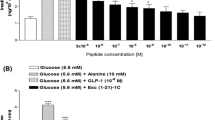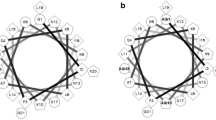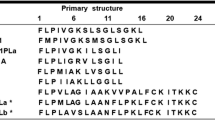Abstract
Hymenochirin-1b (Hym-1B; IKLSPETKDNLKKVLKGAIKGAIAVAKMV.NH2) is a cationic, α-helical amphibian host-defense peptide with antimicrobial, anticancer, and immunomodulatory properties. This study investigates the abilities of the peptide and nine analogues containing substitutions of Pro5, Glu6, and Asp9 by either l-lysine or d-lysine to stimulate insulin release in vitro using BRIN-BD11 clonal β cells or isolated mouse islets and in vivo using mice fed a high-fat diet to produce obesity and insulin resistance. Hym-1B produced a significant and concentration-dependent increase in the rate of insulin release from BRIN-BD11 cells without cytotoxicity at concentrations up to 1 µM with a threshold concentration of 1 nM. The threshold concentrations for the analogues were: [P5K], [E6K], [D9K], [P5K, E6K] and [E6K, D9k] 0.003 nM, [E6K, D9K] and [D9k] 0.01 nM, [P5K, D9K] 0.1 nM and [E6k] 0.3 nM. All peptides displayed cytotoxicity at concentrations ≥1 µM except the [P5K] and [D9k] analogues which were non-toxic at 3 µM. The potency and maximum rate of insulin release from mouse islets produced by the [P5K] peptide were significantly greater than produced by Hym-1B. Neither Hym-1B nor the [P5K] analogue at 1 µM concentration had an effect on membrane depolarization or intracellular Ca2+. The [P5K] analogue (1 µM) produced a significant increase in cAMP concentration in BRIN-BD11 cells and stimulated GLP-1 secretion from GLUTag cells. Down-regulation of the protein kinase A pathway by overnight incubation with forskolin completely abolished the insulin-releasing effects of [P5K]hym-1B. Intraperitoneal administration of the [P5K] and [D9k] analogues (75 nmol/kg body weight) to high-fat-fed mice with insulin resistance significantly enhanced glucose tolerance with a concomitant increase in insulin secretion. We conclude that [P5K]hym-1B and [D9k]hym-1B show potential for development into anti-diabetic agents.








Similar content being viewed by others
Abbreviations
- LDH:
-
Lactate dehydrogenase
- Hym-1B:
-
Hymenochirin-1b
- [Ca2+]i:
-
Intracellular calcium concentration
- IBMX:
-
3-Isobutyl-1-methylxanthine
- PKC:
-
Protein kinase C
- PKA:
-
Protein Kinase A
- GLP-1:
-
Glucagon-like peptide 1
- TNF-α:
-
Tumor necrosis factor α
- IL-17:
-
Interleukin 17
- CPF-6:
-
Caerulein precursor fragment 6
- PMA:
-
Para-methoxyamphetamine
- MALDI-TOF:
-
Matrix-assisted laser desorption/ionization time of flight
- EGTA:
-
Ethylene glycol tetraacetic acid
- CCK8:
-
Cholecystokinin 8
- HEPES:
-
4-(2-Hydroxyethyl)-1-piperazineethanesulfonic acid
References
Abdel-Wahab YH, Marenah L, Flatt PR, Conlon JM (2007) Insulin releasing properties of the temporin family of antimicrobial peptides. Protein Pept Lett 14:702–707
Abdel-Wahab YH, Power GJ, Flatt PR, Woodhams DC, Rollins-Smith LA, Conlon JM (2008a) A peptide of the phyllos/eptin family from the skin of the frog Hylomantis lemur (Phyllomedusinae) with potent in vitro and in vivo insulin-releasing activity. Peptides 29:2136–2143
Abdel-Wahab YHA, Power GJ, Ng MT, Flatt PR, Conlon JM (2008b) Insulin-releasing properties of the frog skin peptide pseudin-2 and its [Lys (18)]-substituted analogue. Biol Chem 389:143–148
Abdel-Wahab YHA, Patterson S, Flatt PR, Conlon JM (2010) Brevinin-2-related peptide and its [D4K] analogue stimulate insulin release in vitro and improve glucose tolerance in mice fed a high fat diet. Horm Metab Res 42:652–656
Attoub S, Arafat H, Mechkarska M, Conlon JM (2013) Anti-tumour activities of the host-defense peptide hymenochirin-1B. Regul Pept 187:51–56
Avan C, Hall D, Katritzky AR (2014) Peptidomimetics via modifications of amino acids and peptide bonds. Chem Soc Rev 43:3575–3594
Conlon JM, Al-Ghaferi N, Abraham B, Leprince J (2007) Strategies for transformation of naturally-occurring amphibian antimicrobial peptides into therapeutically valuable anti-infective agents. Methods 42:349–357
Conlon JM, Power GJ, Abdel-Wahab YHA, Flatt PR, Jiansheng H, Coquet L, Leprince J, Jouenne T, Vaudry H (2008) A potent, non-toxic insulin-releasing peptide isolated from an extract of the skin of the Asian frog, Hylarana guntheri (Anura:Ranidae). Regul Pept 151:153–159
Conlon JM, Mechkarska M, Lukic ML, Flatt PR (2014) Potential therapeutic applications of multifunctional host-defense peptides from frog skin as anti-cancer, anti-viral, immunomodulatory, and anti-diabetic agents. Peptides 57:67–77
Drucker DJ, Lee YC, Asa SL, Brubaker PL (1992) Inhibition of pancreatic glucagon gene expression in mice bearing a subcutaneous glucagon-producing GLUTag transplantable tumor. Mol Endocrinol 6:2175–2184
Flatt PR, Bailey CJ (1981) Abnormal plasma glucose and insulin responses in heterozygous lean (ob/+) mice. Diabetologia 20:573–574
Frost DR (2015) Amphibian species of the world: an online reference. Version 6.0. Electronic database accessible at http://research.amnh.org/herpetology/amphibia/index.php. American Museum of Natural History, New York, USA
Goto M, Maki T, Kiyoizumi T, Satomi S, Monaco AP (1985) An improved method for isolation of mouse pancreatic islets. Transplantation 40:437–438
Green BD, Gault VA, Flatt PR, Harriott P, Greer B, O’Harte FPM (2004a) Comparative effects of GLP-1 and GIP on cAMP production, insulin secretion, and in vivo antidiabetic actions following substitution of Ala8/Ala2 with 2-aminobutyric acid. Arch Biochem Biophys 428:136–143
Green BD, Mooney MH, Gault VA, Irwin N, Bailey CJ, Harriott P, Greer B, O’Harte FPM, Flatt PR (2004b) N-terminal His7-modification of glucagon-like peptide-1(7–36) amide generates dipeptidyl peptidase IV-stable analogues with potent antihyperglycaemic activity. J Endocrinol 180:379–388
Green BD, Mooney MH, Gault VA, Irwin N, Bailey CJ, Harriott P, Greer B, Flatt PR, O’Harte FPM (2004c) Lys9 for Glu9 substitution in glucagon-like peptide-1(7–36)amide confers dipeptidylpeptidase IV resistance with cellular and metabolic actions similar to those of established antagonists glucagon-like peptide-1(9–36) amide and exendin (9–39). Metabolism 53:252–259
Green BD, Gault VA, O’Harte FPM, Flatt PR (2005) A comparison of the cellular and biological properties of DPP-IV resistant N-glucitol analogues of glucagon-like peptide-1 and glucose-dependent insulinotropic polypeptide. Diabetes Obes Metab 7:595–604
Gribble FM, Williams L, Simpson AK, Reimann F (2003) A novel glucose-sensing mechanism contributing to glucagon-like peptide-1 secretion from the GLUTag cell line. Diabetes 52:1147–1154
Henquin JC (2000) Triggering and amplifying pathways of regulation of insulin secretion by glucose. Diabetes 49:1751–1760
Islam MS, du Loots T (2009) Experimental rodent models of type 2 diabetes: a review. Methods Find Exp Clin Pharmacol 31:249–261
Kim JH, Lee JO, Jung JH, Lee SK, You GY, Park SH, Kim HS (2010) Gaegurin-6 stimulates insulin secretion through calcium influx in pancreatic beta Rin5mf cells. Regul Pept 159:123–128
Lacy PE, Kostianovsky M (1967) Method for the isolation of intact islets of Langerhans from the rat pancreas. Diabetes 16:35–39
Lewis RJ, Garcia ML (2003) Therapeutic potential of venom peptides. Nat Rev 2:790–802
Mandal SM, Roy A, Ghosh AK, Hazra TK, Basak A, Franco OL (2014) Challenges and future prospects of antibiotic therapy: from peptides to phages utilization. Front Pharmacol 5:105
McClenaghan NH, Flatt PR, Ball AJ (2006) Actions of glucagon-like peptide-1 on KATP channel-dependent and -independent effects of glucose, sulphonylureas and nateglinide. J Endocrinol 190:889–896
Mechkarska M, Prajeep M, Coquet L, Leprince J, Jouenne T, Vaudry H, King JD, Conlon JM (2012) The hymenochirins: a family of host-defense peptides from the Congo dwarf clawed frog Hymenochirus boettgeri (Pipidae). Peptides 35:269–275
Mechkarska M, Prajeep M, Radosavljevic GD, Jovanovic IP, Al Baloushi A, Sonnevend A, Lukic ML, Conlon JM (2013) An analog of the host-defense peptide hymenochirin-1B with potent broad-spectrum activity against multidrug-resistant bacteria and immunomodulatory properties. Peptides 50:153–159
Meier JJ, Gallwitz B, Nauck MA (2003) Glucagon-like peptide-1 and gastric inhibitory polypeptide: potential applications in type 2 diabetes mellitus. Biodrugs 2:93–102
Nattrass M, Bailey CJ (1999) New agents for type 2 diabetes. Best Pract Res Clin Endocrinol Metab 13:309–329
Ojo OO, Abdel-Wahab YHA, Flatt PR, Conlon JM (2013a) Insulinotropic actions of the frog skin host-defense peptide alyteserin-2a: a structure-activity study. Chem Biol Drug Des 82:196–204
Ojo OO, Conlon JM, Flatt PR, Abdel-Wahab YH (2013b) Frog skin peptides (tigerinin-1R, magainin-AM1, -AM2, CPF-AM1, and PGla-AM1) stimulate secretion of glucagon-like peptide 1 (GLP-1) by GLUTag cells. Biochem Biophys Res Commun 431:14–18
Ojo OO, Srinivasan DK, Owolabi BO, Conlon JM, Flatt PR, Abdel-Wahab YHA (2015a) Magainin-AM2 improves glucose homeostasis and beta cell function in high-fat fed mice. Biochim Biophys Acta 1850:80–87
Ojo OO, Srinivasan DK, Owolabi BO, Flatt PR, Abdel-Wahab YH (2015b) Beneficial effects of tigerinin-1R on glucose homeostasis and beta cell function in mice with diet-induced obesity-diabetes. Biochimie 109:18–26
Peters A (2010) Incretin-based therapies: review of current clinical trial data. Amer J Med 123:S28–S37
Pospisilik JA, Martin J, Doty T, Ehses JA, Pamir N, Lynn FC, Teau S, Demuth H-U, McIntosh CHS, Pederson RA (2003) Dipeptidyl peptidase IV inhibitor treatment stimulates cell survival and islet neogenesis in streptozotocin-induced diabetic rats. Diabetes 52:741–750
Reimann F, Williams L, da Silva Xavier G, Rutter GA, Gribble FM (2004) Glutamine potently stimulates glucagon-like peptide-1 secretion from GLUTag cells. Diabetologia 47:1592–1601
Serra I, Scorciapino MA, Manzo G, Casu M, Rinaldi AC, Attoub S, Mechkarska M, Conlon JM (2014) Conformational analysis and cytotoxic activities of the frog skin host-defense peptide, hymenochirin-1Pa. Peptides 61:114–121
Srinivasan D, Mechkarska M, Abdel-Wahab YHA, Flatt PR, Conlon JM (2013) Caerulein precursor fragment (CPF) peptides from the skin secretions of Xenopus laevis and Silurana epitropicalis are potent insulin-releasing agents. Biochimie 95:429–435
Srinivasan D, Ojo OO, Abdel-Wahab YHA, Flatt PR, Guilhaudis L, Conlon JM (2014) Insulin-releasing and cytotoxic properties of the frog skin peptide, tigerinin-1R: a structure-activity study. Peptides 55:23–31
Tokuda M, Katsuno T, Ochi F, Miyakoshi K, Kusunoki Y, Murai K, Miuchi M, Hamaguchi T, Miyagawa J, Namba M (2014) Effects of exenatide on metabolic parameters/control in obese Japanese patients with type 2 diabetes. Endocr J 61:365–372
Tolhurst G, Zheng Y, Gribble FM (2011) Glutamine triggers and potentiates glucagon-like peptide-1 secretion by raising cytosolic Ca2+ and cAMP. Endocrinology 152:405–413
Wang CY, Liao JK (2012) A mouse model of diet-induced obesity and insulin resistance. Methods Mol Biol 821:421–433
Zhang HJ, Zhou F, Ji BP, Li B, Luo YC, Yu HQ, Zhang GZ (2009) Effects of fructose and/or fat in the diet on developing the type 2 diabetic-like syndrome in CD-1 mice. Horm Metab Res 41:40–45
Acknowledgments
This study was supported by the University of Ulster Research Strategy Funding and an award of a University Vice Chancellor Research Studentship to DKS. We thank Professor D. Drucker for access to GLUTag cells.
Author information
Authors and Affiliations
Corresponding author
Ethics declarations
Conflict of interest
No conflict of interest declared.
Additional information
Handling Editor: M. S. Palma.
Rights and permissions
About this article
Cite this article
Owolabi, B.O., Ojo, O.O., Srinivasan, D.K. et al. In vitro and in vivo insulinotropic properties of the multifunctional frog skin peptide hymenochirin-1B: a structure–activity study. Amino Acids 48, 535–547 (2016). https://doi.org/10.1007/s00726-015-2107-x
Received:
Accepted:
Published:
Issue Date:
DOI: https://doi.org/10.1007/s00726-015-2107-x




